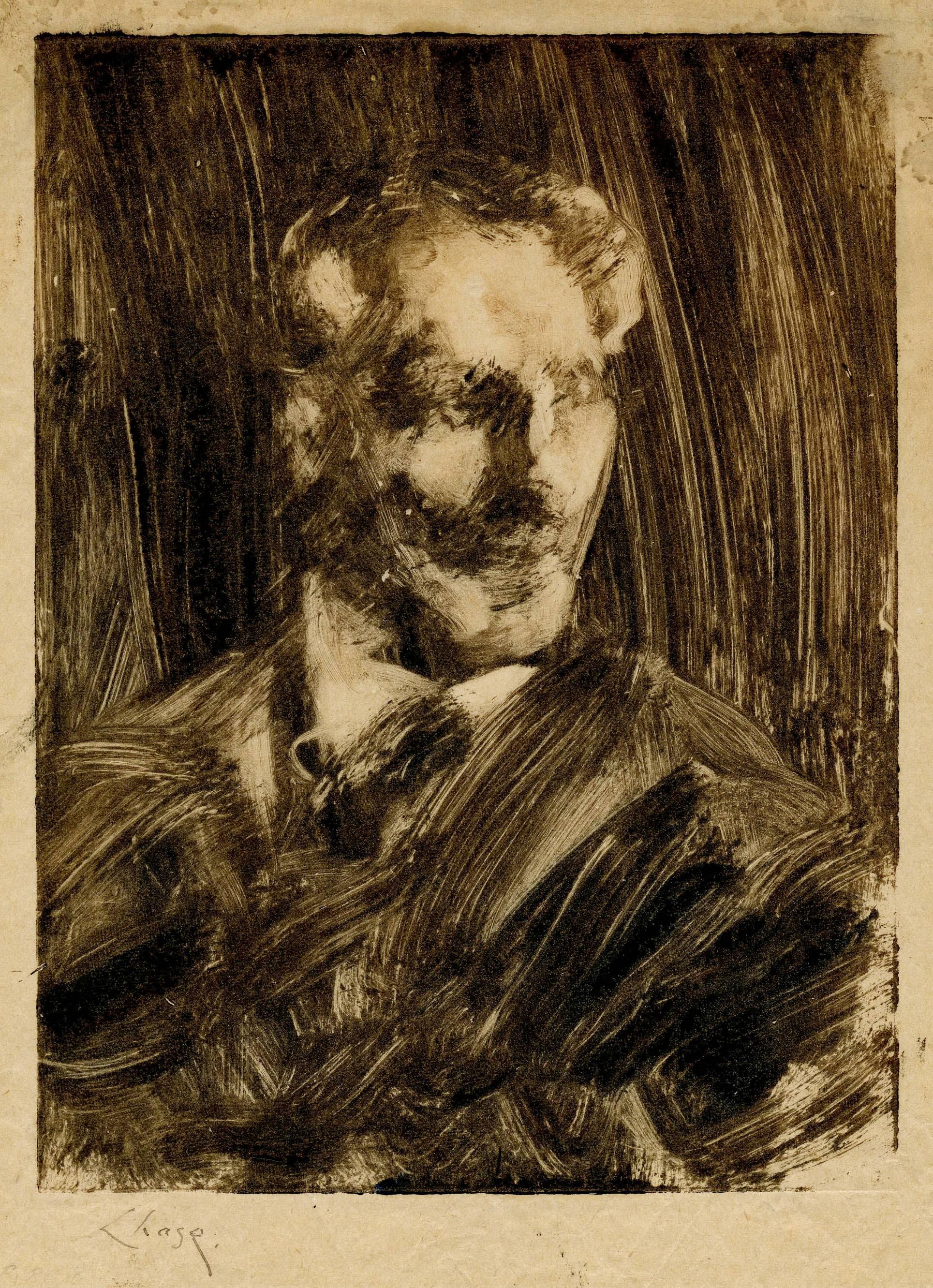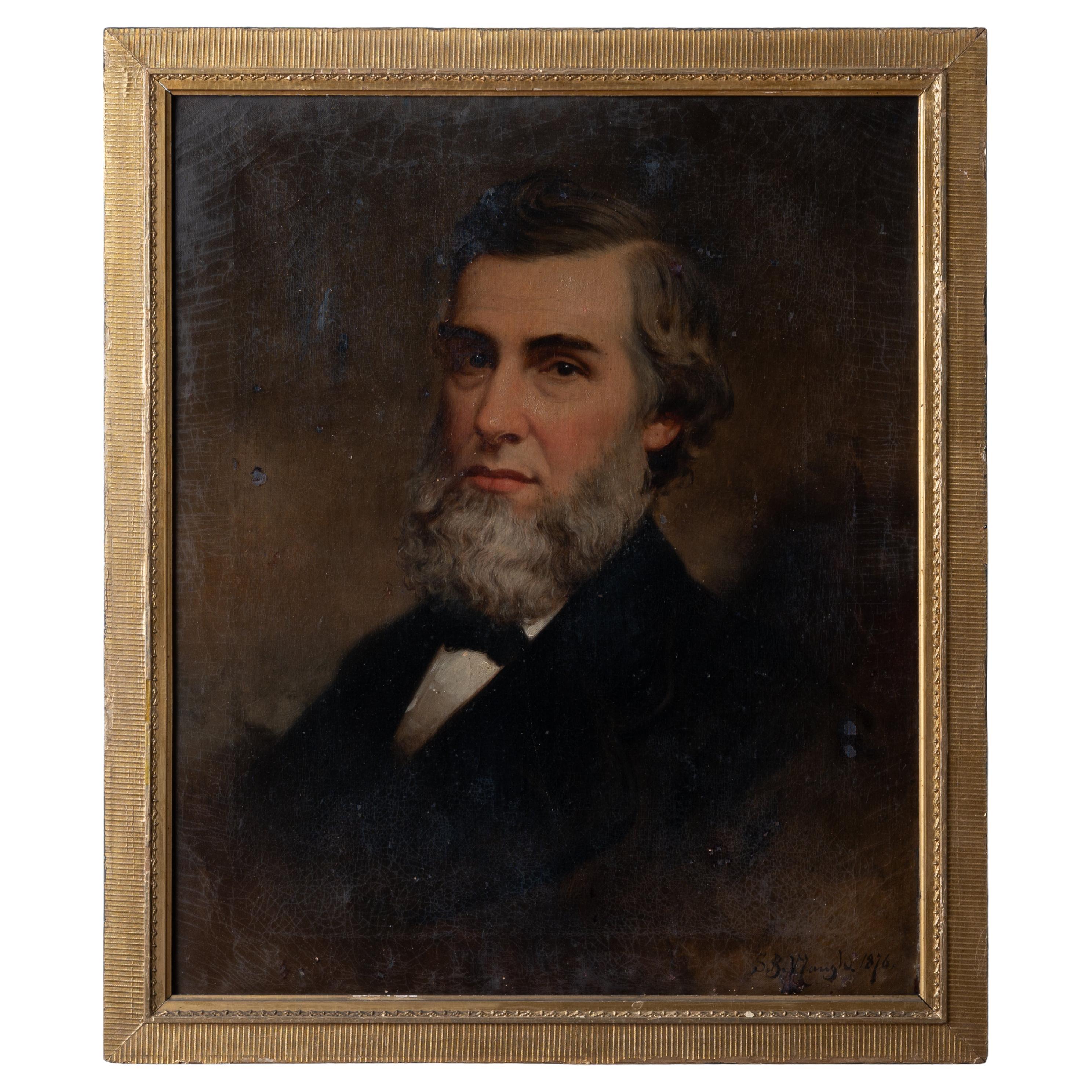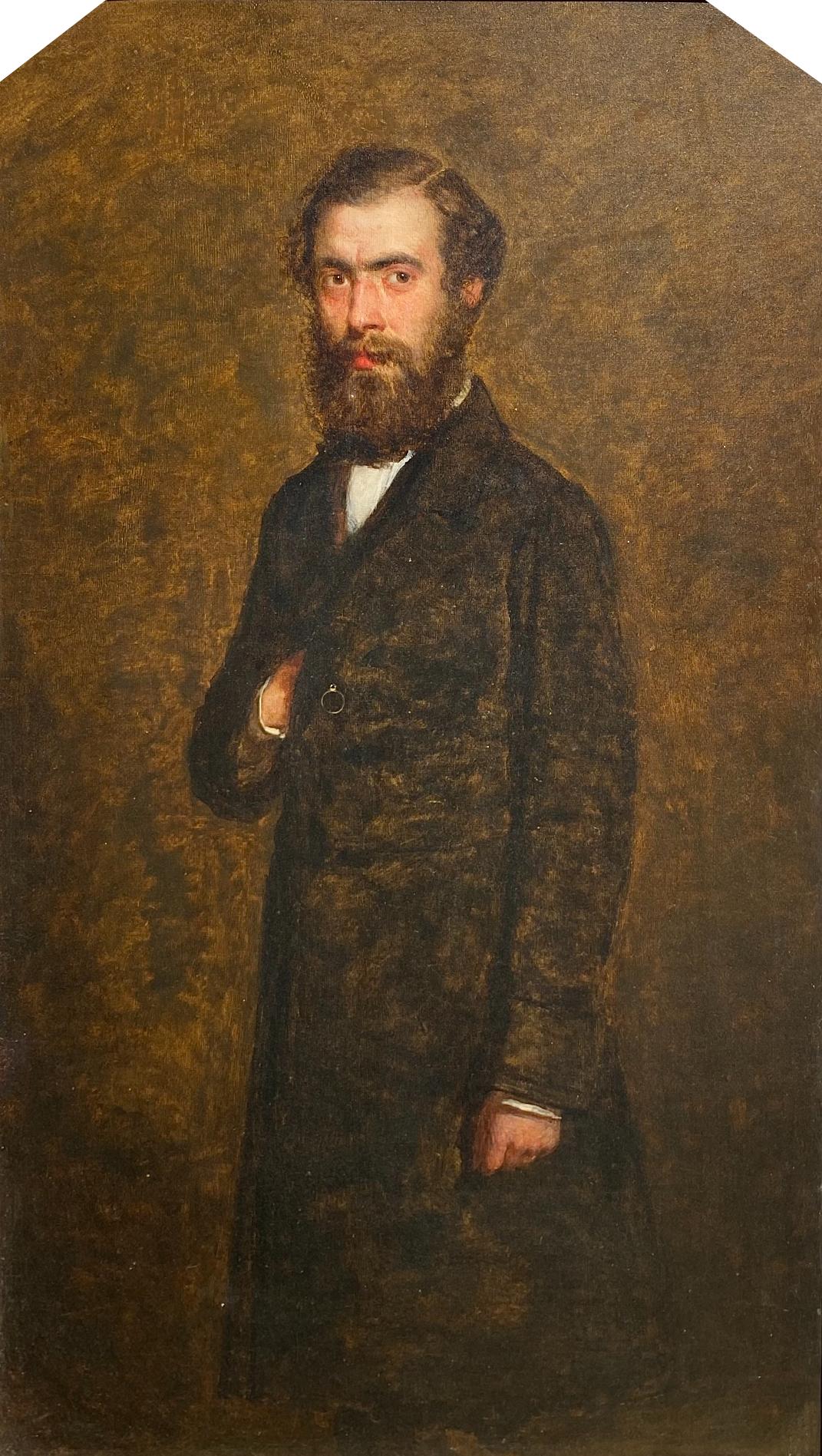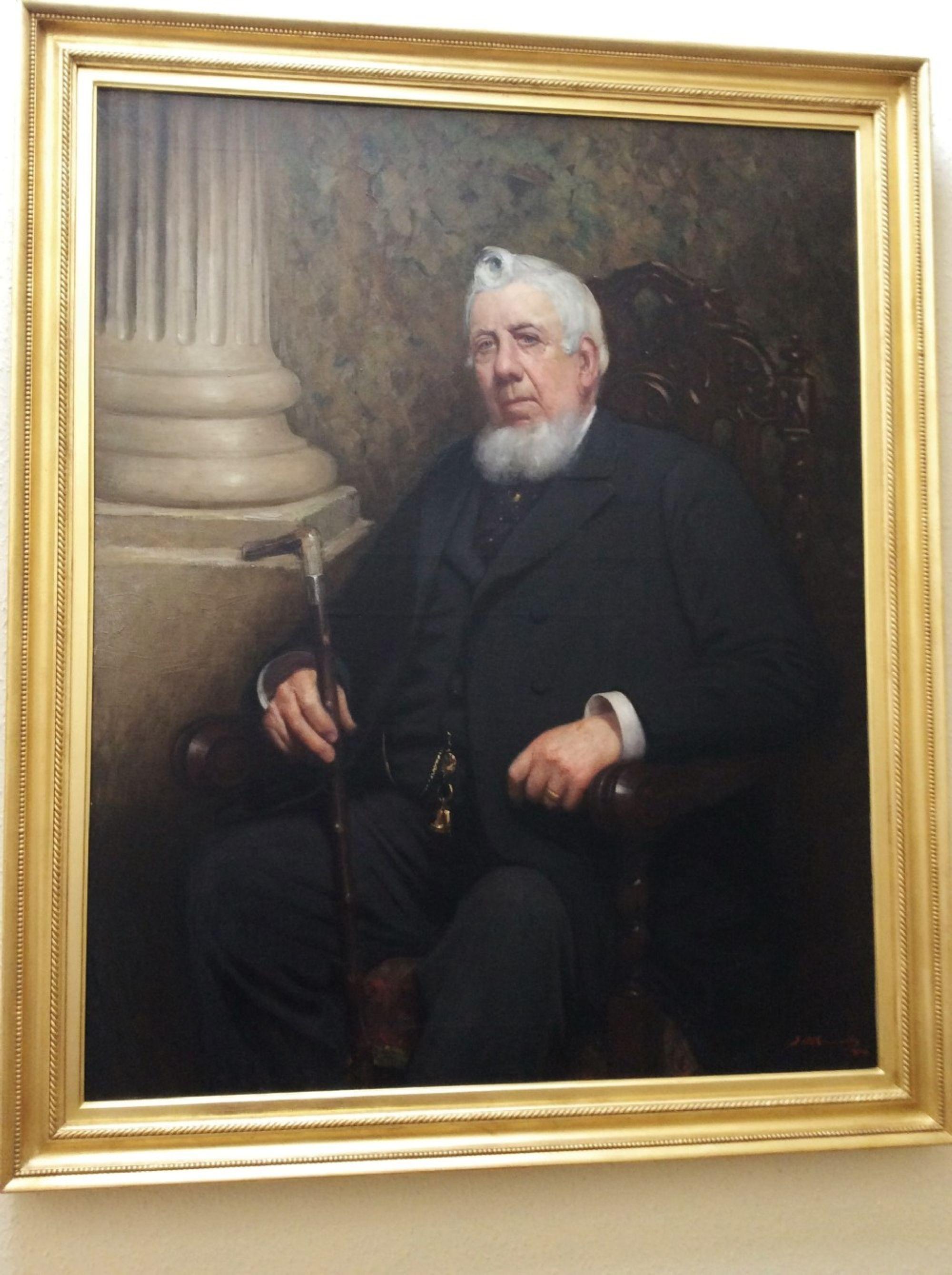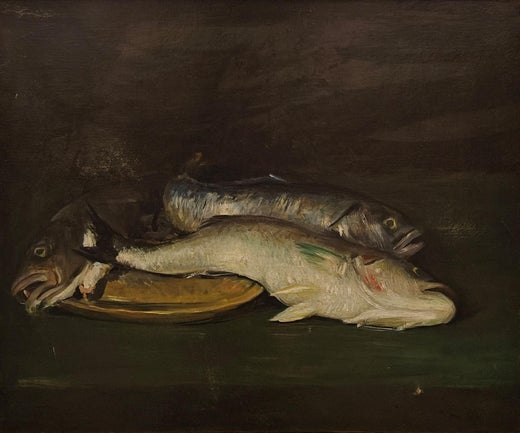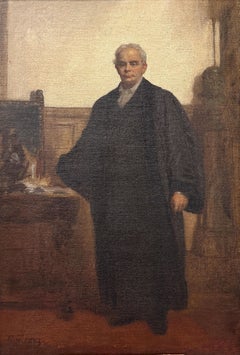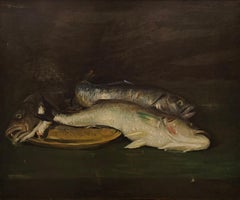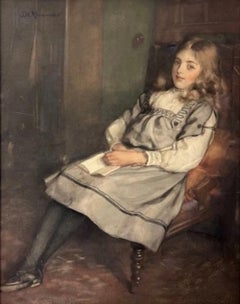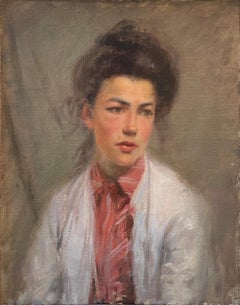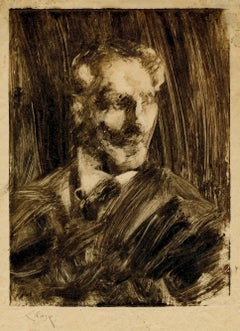Items Similar to "Portrait of Louis Prang" William Merritt Chase, Impressionist Portrait
Want more images or videos?
Request additional images or videos from the seller
1 of 6
William Merritt Chase"Portrait of Louis Prang" William Merritt Chase, Impressionist Portrait1884
1884
$47,000
£35,573.97
€40,962.86
CA$66,862.40
A$72,428.52
CHF 38,136.56
MX$879,132.59
NOK 475,610.82
SEK 449,678.88
DKK 305,799.62
About the Item
William Merritt Chase
Portrait of Louis Prang, 1884
Signed center right "WM M Chase"
Oil on canvas
41 1/2 x 30 1/2 inches
Provenance
The artist
Louis Prang
Gift from the sitter to Rosa Heinzen Roewer (daughter of Karl F. Heinzen who worked in Prang's factory in Roxbury, Massachusetts), circa 1898
By descent to her son, 1946
Private Collection, Florida
Literature
"The Art Interchange", June 19, 1884, p. 148.
Wilber Peat, "Checklist of Known Work by William M. Chase", Chase Centennial Exhibition, Indianapolis, Indiana, 1949.
Ronald G. Pisano, William Merritt Chase: Portraits in Oil, Vol. II, New Haven, 2006, p. 52, cat. no. OP.103.
Louis Prang (1824-1909) is known as the 'Father of the American Christmas Card.' Prang immigrated to Boston from Silesia and started a chromolithographic printing company, L. Prang & Co. He started printing Christmas greeting cards between 1873-1875 and later printed cards for other holidays. He was also the leading producer of Fine Art prints of the era reproducing many paintings of the period.
William Merritt Chase, son of a shopkeeper, left Indiana at the age of twenty to study at the National Academy of Design in New York. Domestic financial reverses interrupted his studies as his family resettled in St. Louis. Young William's talent so impressed several businessmen in that city that they proposed to underwrite his further study abroad. In 1872, Chase began attendance at the Royal Academy in Munich, where he remained six years and acquired the flashy old-master style with dark palette and virtuoso brushwork, which characterized that popular academy. A sojourn in Venice with fellow students Frank Duveneck and John Twachtman rounded out his European training. He returned to New York in 1898 to assume a teaching post at the Art Students League, beginning an enormously successful thirty-eight-year career that would include such students as Edward Hopper, Georgia O'Keeffe, Rockwell Kent, and Charles Sheeler.
Once settled into Manhattan, Chase rented studio space in the old Tenth Street Studios, previously occupied by painters of the Hudson River school. Brimming with self-confidence and resolved not to be outshone in his accommodations, Chase acquired the vast salon space in which Albert Bierstadt had executed his monumental western landscapes. At great expense, Chase converted the studio into an exotic showplace, which became a social center for the local artistic fraternity; the gesture enhanced his reputation as a genteel Bohemian and also attracted numerous prestigious and remunerative portrait commissions.
In 1881 the Belgian painter Alfred Stevens encouraged Chase to abandon the bravura old-master technique he had acquired in Munich and to experiment with a modified impressionist style by lightening his palette and enlivening his picture surface with looser, more painterly brushwork. Chase explored this new direction further by experimenting with pastel and plein air painting.
In 1886 he married Alice Gerson, a family friend who had modeled for him, and they produced a large family whose members became favored subjects for his brush.
In 1892 he built a summer home at Shinnecock on the south branch of Long Island. There, among the dunes, in the bright sunlight and sea air his painterly impulse was given free sway, and he produced some of his freest and loveliest work. Shinnecock also became one of his most successful and popular teaching venues, and he was encouraged to initiate the Chase School in Manhattan, which was modeled on the Académie Julian in Paris. But Chase lacked the business acumen to make it succeed, and under other management it became the New York School of Art.
During these years Chase had developed and continued to employ two different styles of painting: the impressionistic plein air landscapes and genre scenes, and the somber realism of his portraits and still-life works. In his later years his still-life oeuvre was enhanced by an extraordinary series of fish studies, in which the artist's virtuoso brush transforms the pink and white luminosity of the recumbent fish to an object of almost abstract beauty. He often executed such studies in three or four hours.
In 1902, after the premature death of his friend John Twachtman, Chase was invited to join the recently organized Ten American Painters and he continued to exhibit with them until the end of his working career. After a long and painful illness, Chase died in 1916, at the age of sixty-seven, mourned by hundreds of devoted students. Sadly, only three years before, examples of his work had been excluded from the momentous Armory Show, which signaled a new era for American art. Chase's reputation languished for several decades thereafter.
- Creator:William Merritt Chase (1849-1916, American)
- Creation Year:1884
- Dimensions:Height: 48 in (121.92 cm)Width: 38 in (96.52 cm)
- More Editions & Sizes:Unique WorkPrice: $47,000
- Medium:
- Movement & Style:
- Period:
- Condition:
- Gallery Location:New York, NY
- Reference Number:1stDibs: LU1841216343712
William Merritt Chase
William Merritt Chase rejected his father’s shoe business in favor of studying art professionally, training with Barton S. Hayes in Indianapolis and going abroad to the Royal Academy in Munich. His brushwork and use of light was similar to the French Impressionists, and his style of visual modelling was particularly influenced by Eduoard Manet. After he finished his studies Chase travelled to New York City and began teaching as part of the Art Students League, quickly becoming a renowned teacher. He incorporated Impressionist techniques along with his more traditional European education to create unique images imbued with the valued urbanization and expansion of New York City. Later in his life, Chase established the Chase School, which eventually was renamed the Parsons School of Design.
About the Seller
5.0
Platinum Seller
Premium sellers with a 4.7+ rating and 24-hour response times
Established in 2022
1stDibs seller since 2022
123 sales on 1stDibs
Typical response time: <1 hour
- ShippingRetrieving quote...Shipping from: New York, NY
- Return Policy
Authenticity Guarantee
In the unlikely event there’s an issue with an item’s authenticity, contact us within 1 year for a full refund. DetailsMoney-Back Guarantee
If your item is not as described, is damaged in transit, or does not arrive, contact us within 7 days for a full refund. Details24-Hour Cancellation
You have a 24-hour grace period in which to reconsider your purchase, with no questions asked.Vetted Professional Sellers
Our world-class sellers must adhere to strict standards for service and quality, maintaining the integrity of our listings.Price-Match Guarantee
If you find that a seller listed the same item for a lower price elsewhere, we’ll match it.Trusted Global Delivery
Our best-in-class carrier network provides specialized shipping options worldwide, including custom delivery.More From This Seller
View All"John Van Schaick Lansing Pruyn" Eastman Johnson, Prominent Gentleman Portrait
By Eastman Johnson
Located in New York, NY
Eastman Johnson
John Van Schaick Lansing Pruyn, 1883
Initialed and dated lower left
Oil on canvas
28 x 18 inches
For many years the foremost genre painter in the United States, Eas...
Category
1880s Academic Figurative Paintings
Materials
Canvas, Oil
"Still Life of Fish" William Merritt Chase, American Impressionist Bravura
By William Merritt Chase
Located in New York, NY
William Merritt Chase
Still Life of Fish
Signed lower right
Oil on canvas
32 x 39 1/2 inches
Provenance
Francis E. Myers, III, Ashland, Ohio
Butler Institute of American Art, Youngs...
Category
Early 1900s American Impressionist Still-life Paintings
Materials
Canvas, Oil
"Tired" John White Alexander, Portrait in Interior, American Impressionist
By John White Alexander
Located in New York, NY
John White Alexander
Tired, circa 1910
Inscribed on the reverse: Mrs Lee Bauer, _____,
Inscribed on the reverse: "Tired"
Watercolor on paper
16 1/2 x 13 inches
John White Alexander...
Category
1910s American Impressionist Interior Paintings
Materials
Watercolor, Paper
"Marion Jones Farquhar" Frederick William Macmonnies, Tennis Olympian Portrait
By Frederick William MacMonnies
Located in New York, NY
Frederick William Macmonnies
Marion Jones Farquhar, 1905-11
Oil on canvas
24 x 20 inches
Provenance:
William Clerk
Private Collection, New York
Literature:
Mary Smart, A Flight with Fame: The Life and Art of Frederick MacMonnies, with a Catalogue Raisonne of Sculpture and a Checklist of Paintings by E. Adina Gordon, Madison, Connecticut, 1996, no. 90.
The work depicts Marion Jones Farquhar who, was an American tennis player who competed during the late 19th century and early 20th century. She won the singles titles at the 1899 and 1902 U.S championships and was the first American woman to medal at the Olympics placing Bronze in singles. Additionally, she was the artist's sister-in-law who often played and competed with MacMonnies in golf and tennis. MacMonnies would often study the movements of her form referenced in his sculpture. When MacMonnies won a doubles golf tournament he said "Marion dragged my dead weight thro' and won us the tournament, showing what great Generalship can do."
A sculptor of classical figures, American-born Frederick MacMonnies had fame in the United States and Europe in the later half of the 19th century and early 20th century. He occasionally returned to America but lived most of his life as in expatriate in France. He was especially known for his lithe bronze figures, especially ones titled Diana. The classical names of these figures allowed him the appearance of propriety but gave him the opportunity to model svelte nudes.
Frederick MacMonnies was one of the first American sculptors to recognize the potential market of the middle class. He copyrighted his works and then contracted with foundries to mass produce some of his figures such as Diana in smaller sizes.
MacMonnies was born in Brooklyn, New York, and was a child prodigy at carving stone. At age 18, he worked in the studio of Augustus Saint-Gaudens, and then persuaded him to become his assistant, keeping models damp and covered, running errands, and cleaning the studio. Evenings he studied at the Art Students League, Cooper Union, and the National Academy of Design.
In Saint-Gaudens' studio, he met many of the wealthy people who shared Saint-Gaudens Beaux-Arts based ideas that art and architecture should be unified in order to create public art in America equal to that of classical antiquity or Renaissance Europe. Among the men that MacMonnies met through Saint-Gaudens who later furthered his career were architects Stanford White and Charles McKim...
Category
Early 1900s American Impressionist Portrait Paintings
Materials
Canvas, Oil
"Portrait of an Italian Fencer, " John Frederick Kensett, Hudson River School
By John Frederick Kensett
Located in New York, NY
John Frederick Kensett (1816 - 1872)
Portrait of an Italian Fencer, circa 1845-47
Watercolor on wove paper
13 1/8 x 8 1/8 inches
Signed with initials and inscribed lower right "J.F.K. Rome"
From October 1845 through the spring of 1847, Kensett lived in Rome. He attended classes where he sketched from live models, and he sketched in the countryside outside Rome and around Florence, Perugia, and Venice, places he visited with his artist friends. He fulfilled commissions for paintings from Americans in Italy, and by 1847 his career was well established.
Son of an English immigrant engraver, John Kensett lacked enthusiasm for that medium and became one of the most accomplished painters of the second generation of Hudson River School painters. His reputation is for Luminism, careful depiction of light, weather, and atmosphere as they affect color and texture of natural forms. He was particularly influenced by the painting of Asher Durand in that he focused on realism and detail rather than the highly dramatic views associated with Thomas Cole. Going to the western United States in the mid 1850s and the 1860s, he was the first of the Hudson River School painters to explore and paint the West.
Kensett was born and raised in Cheshire, Connecticut, and learned his engraving from his father, Thomas Kensett with whom he worked in New Haven, Connecticut until 1829. He continued working until 1840 as an engraver of labels, banknotes and maps and was employed part of that time by the American Bank Note Company in New York City. There he met Thomas Rossiter, John Casilear, and other artists who urged him to pursue painting. In 1840, he and Rossiter, Asher Durand, and Casilear went to Europe where Kensett stayed for seven years and supported himself by doing engraving but became accomplished in landscape painting.
Having sent canvases of Italian landscapes back to New York, he had a reputation for skillful painting that preceded him. When he returned to New York City in 1847, he was an "instant success" and very sought after by collectors. Two of his Italian landscapes had already been purchased by the American Art Union. By 1849, he was a full member of the National Academy of Design and was generally popular among his peers. His studio was a gathering place with travelers stopping by to see his canvases and to identify "precise locations in the Catskills or Newport or New England in the oil sketches and drawings that covered his walls." (Zellman 170). For the women, he was a popular bachelor, "romantic looking with high forehead and sensitive expression." (Samuels 262)
He was also sought after by many organizations. Among his activities were serving on the committee to oversee the decoration of the United States Capitol in Washington DC, and becoming one of the founders of the Metropolitan Museum in New York.
An inveterate traveler, Kensett spent summers on painting excursions away from New York City. One of these trips was a special painting excursion with fifteen other artists sponsored by the B & O Railroad from Baltimore, Maryland to Wheeling, West Virginia. Unlike many of the Hudson River painters...
Category
1840s Hudson River School Figurative Paintings
Materials
Paper, Watercolor
"Portrait of Fanny Adam" Mary Jane Peale, Mid-19th Century, Early Portrait
Located in New York, NY
Mary Jane Peale
Portrait of Fanny Adam, 1857
A scanned photograph of the back of the canvas taken prior to relining shows the inscription "Fanny Adam / painted by / Mary J. Peale / P...
Category
1850s Academic Figurative Paintings
Materials
Canvas, Oil
You May Also Like
Portrait of William Merritt Chase
By Walter Shirlaw
Located in Douglas, Isle of Man
Attributed to Walter Shirlaw 1838-1909, was a Scottish born American painter who lived in America from the age of two years old. Shirlaw studied in Munich where he befriended America...
Category
Early 1900s Portrait Paintings
Materials
Canvas, Oil
Portrait of a Man Facing Left
By William Merritt Chase
Located in Fairlawn, OH
Portrait of a Man Facing Left
Monotype printed in brown ink, c. 1880-1914
Signed in ink lower left: Chase (see photo)
Provenance:
Helen Chase Storm (the artist's daughter)
Jackson Chase Storm (her son)
Chapellier Galleries (as agent)
James Bergquist, Boston
References And Exhibitions:
Exhibited at the Museum of Fine Arts, Boston and the Clark Art Institute, Williamstown, MA. (See MFA paperwork in photos)
Reference:
Ronald G. Pisano, Completed by D. Frederick Baker and Carolyn K. Lane, William Merritt Chase: Still Lifes, Interiors, Figures, Copies of Old Masters, and Drawings, Catalogue Raisonne, Vol. IV (New Haven and London: Yale University Press, 2010), Vol. 1, M. 8. (See photos of entry)
William Merritt Chase (1840-2016)
Born in Nineveh, Indiana Died New York, New York
In 1883 Chase was involved in the organization of an exhibition to help raise funds for a pedestal for the Statute of Liberty. The exhibition featured loans of three works by Manet and urban scenes by the Italian Impressionist Giuseppe de Nittis. Both artists influenced Chase's Impressionistic style that gave rise to a series of New York park scenes. It is also thought that he was influenced by John Singer Sargent's In the Luxembourg Gardens (1879) which was exhibited in New York at this time. Indeed, Chase had met Sargent in Europe in 1881, the two men becoming lifelong friends with Sargent painting Chase's portrait in 1902.
On another European trip in 1885, Chase met James McNeill Whistler in London. While Whistler had a reputation for being difficult, the two artists got along famously and agreed to paint one another's portrait. Eventually, however, Whistler's moods began to grate with Chase who wrote home stating "I really begin to feel that I never will get away from here". For his part, Whistler criticized Chase's finished portrait and, according to Hirshler, "complained about Chase for the rest of his life". While no record exists of Whistler's portrait of Chase; Chase's portrait of Whistler remains a well-known piece in his oeuvre.
In 1887 Chase married Alice Gerson, the daughter of the manager of a lithography company. Though some fifteen years his junior (Chase was 37), he had known Alice for some time through her family's devotion to the arts. The pair, who would enjoy a happy marriage with Alice in full support of her husband's career, settled initially in Brooklyn...
Category
1890s Impressionist Portrait Prints
Materials
Monoprint
Samuel Waugh Portrait Painting of Robert Patterson, Philadelphia, 1876
Located in Savannah, GA
Samuel Waugh
(American, 1814-1885)
Portrait painting of Robert Patterson, Sr., (Philadelphia, 1819-1909).
canvas: 20 by 24 inches
frame: 23 by 27 inches
Category
Antique 1870s American Paintings
Materials
Canvas, Giltwood
Portrait of a Gentleman - British Edwardian art male portrait oil painting
Located in Hagley, England
This lovely British Edwardian Impressionist portrait oil painting is by noted artist Percy William Gibbs. Pained circa 1910 it is a head and shoulders portrait of a gentleman in a da...
Category
1910s Impressionist Portrait Paintings
Materials
Oil
Portrait of Doctor Carter, Scottish 19th Century Signed Oil Painting
Located in London, GB
Oil on board, signed, titled and dated '1858' on verso
Image size: 10 1/2 x 18 1/2 inches (26.5 x 47 cm)
Gilt frame
This is a wonderful portrait that was painted by John Burr at a t...
Category
Late 19th Century Portrait Paintings
Materials
Oil, Board
Portrait Of A Gentleman George Williams Kenworthy by John Dalziel Kenworthy
Located in York, GB
John Dalziel Kenworthy portrait of a gentleman . Fine, large and imposing oil on canvas housed in a gilt frame.
The sitter is unidentified, he has an aristocratic and characterful lo...
Category
Early 1900s Old Masters Portrait Paintings
Materials
Oil
More Ways To Browse
Antique Holiday
Christmas Card
Monumental Old Masters Oil Paintings
Kent Rockwell
Sphinx Painting
Vintage Ballroom Dancing
Zhaoming Wu
15th Century Oil Painting
1930s Modernist Painting
19th Century Painting Music
4 Feet X 5 Feet Oil Paintings
Adam And Eve Paintings
Adam Eve Oil Canvas
Alexej Ravski
Athena Painting
Bart Simpson
Calendar Girls
Claudia Griesbach Martucci

